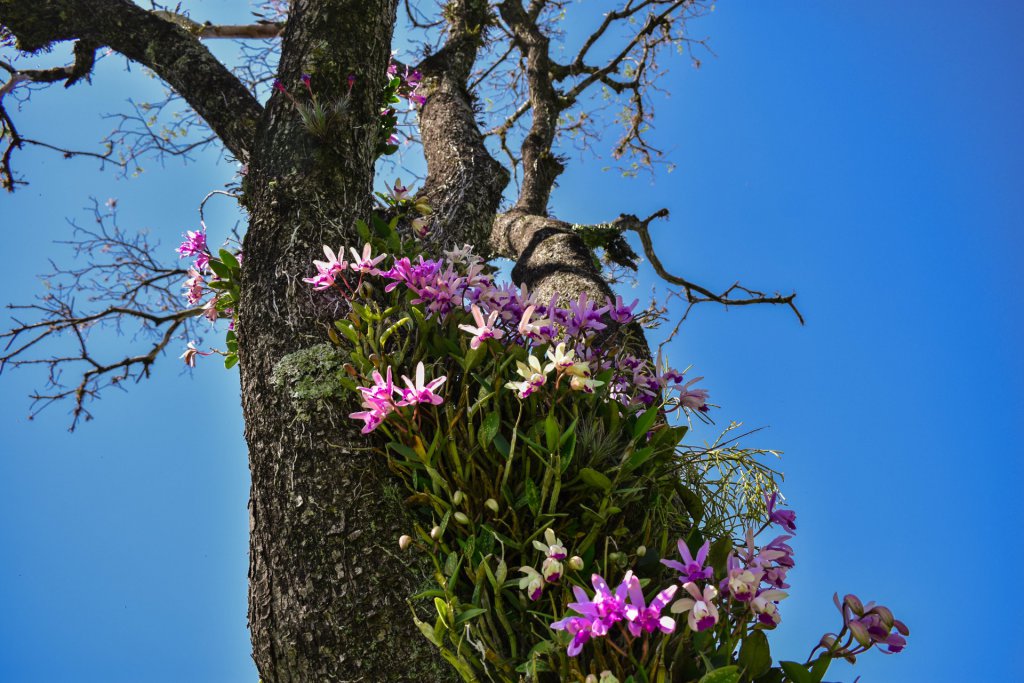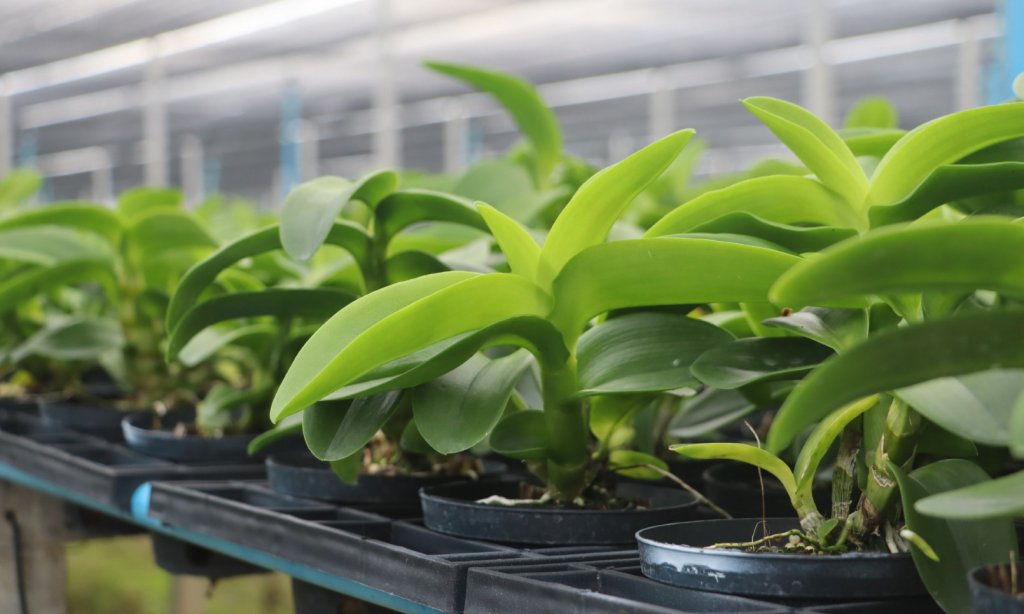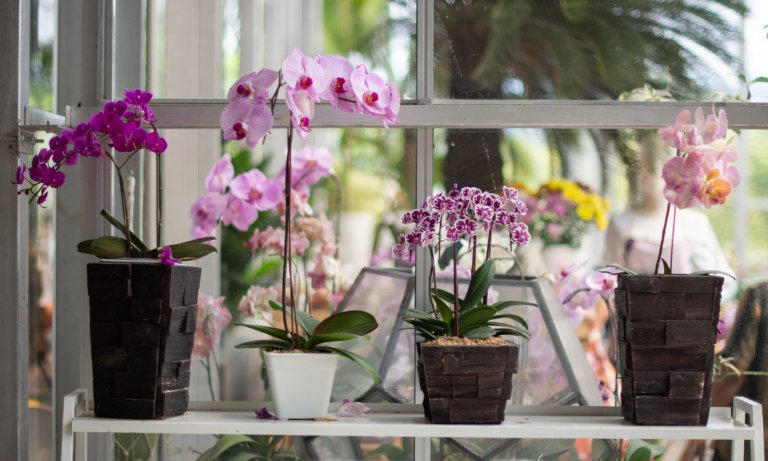Temperature, humidity, and watering frequency are all key to having a healthy orchid. However, light is probably the most important variable. The number of hours of light exposure, and the intensity and quality of the light, have a major impact on a plant’s growth and overall health. Adequate lighting is also critical in triggering the flowering process.
It’s often tricky to find out if a room has enough brightness for your orchid because our eyes adjust to a range of lighting conditions. There are many ways to get a pretty good idea of whether the light levels are adequate for your orchid.
Aside from specific requirements for various species, we will also share some general lighting advice and tips that apply to all orchids.
Basic Principles of Lighting for Orchids
The most important characteristics of light for your orchid are intensity, quality, and duration, also known as the photoperiod.
Light intensity is what we perceive as brightness, and is to do with the amount of light that the plant receives. A standard measurement for intensity, often used by growers, is foot-candles. You can measure this with a light meter. Alternatively, you can use the ‘hand test’ described further down in this article.
What we perceive as white light from the sun is actually made up of all the colors that we know. Light quality measures the relative amount of blue, green, red, and other portions of the spectrum. Plants use various colors of light for different functions.
For example, red is needed for reproduction and blue for photosynthesis and growth. You don’t need to worry about this if you are using sunlight as the primary source of light. However, a good understanding of light quality is essential for those who grow orchids under artificial lights.
Light duration is an important factor in balancing the life cycle of plants. Orchids use the change in day length to tell the difference in the seasons, hence adjusting their growth and blooming periods. Growers often change the number of hours of light to time the flowering of certain orchids, like Cattleyas.
Light Requirements for Types of Orchid
The light requirements of different orchids vary. In general, you should provide your orchid with a level of lighting similar to what they get in their natural habitat.
Depending on the amount of light that different types of orchids require, we have categorized them into three main groups:
Low Light Orchids
Examples: Phalaenopsis, Paphiopedilum

Low light orchids require between 1000 and 2000 foot-candles, and they should not be exposed to bright direct light. The main reason why low light orchids should be kept away from direct sunshine is that they are more susceptible to leaf burns compared to other orchids. However, they will not grow well if you keep them in darkness, for example, on a remote shelf or in a dim corner of the room.
The ideal place for a low light orchid is in bright shade, near a sunny window, but where they don’t get exposure to direct sunlight. However, if the plant gets just a bit of sunshine early in the morning or late in the day, this is fine as sunburn is unlikely to occur due to this limited exposure.
Remember to check the specifics for your plant, as there may be variations even within one genus. For example, growers often claim that Paphiopedilum orchids that have mottled leaves can tolerate higher light than the strap-leaved Paps.
These orchids, which do not prefer direct sunshine on their leaves, are perfect candidates for growing under artificial light.
Moderate Light Orchids
Examples: Cattleyas, Dendrobiums

Medium-light orchids require between 2000 and 3000 foot-candles of light. As expected, their requirements are between low and high light orchids.
They grow well in bright shade. However, sun exposure during the morning and evening is very important. These hours of direct sunshine are often a key factor in making these orchids bloom.
They grow better in the shade near a big bright window, where they can get some filtered sunlight.
These orchids can also grow under artificial light. The light source should be closer than for low light orchids. Usually, it should be about 10 inches away from the plant.
High Light Orchids
Examples: Vandas, Cymbidiums, Ascocenda, Oncidiums

These orchids can tolerate up to 6000 foot-candles. However, you should check the specific light requirements for your species as the sun tolerance can vary for these orchids. The ones that are on the lower end of this spectrum will do better in filtered sun, so you can place them behind a sheer curtain.
The best place for high light orchids is an east- or south-facing windowsill. Direct sunlight coming from a window, depending on your geographical location, can range between 4000 and 8000 foot-candles measured directly by the glass.
Orchids grow typically in the rainforests, quite high on the tree trunks, and as you can imagine, they get some shade from the trees above them. Therefore, when we talk about high light orchids, it does not mean that they prefer to stay in the sun all day. They can still get sunburnt if they are exposed to hot sunshine for extended periods.
How to Measure Light Brightness
Once you know how much light your orchid needs, you should find a place with the appropriate amount of light. An easy way to measure light levels is with the hand test. You do not need any tools to perform this test, so it is quick and easy to do yourself.
On a clear day, place your hand between the leaves and the light source, about one foot away from the orchid leaves, and look at the shadow your hand creates.
- If you see no shadow at all, you are in a very low light environment. This is too low for almost all orchids.
- If you see a barely noticeable shade, this is a low light environment.
- If the shadow is noticeable and you see a faint outline of your hand, this is a medium-light environment.
- If you see a sharp dark shadow, this is a high light environment.
The hand shadow test is only an approximation, but it should give you a good idea of whether your orchid is receiving the right amount of light. You can also use a light meter, a simple device to measure the intensity with much higher accuracy.

Another quick measurement you can easily do by using your hand is feeling the temperature of the leaves. If the leaves feel warmer than your hand on touching, your plant is receiving too much sunlight. This will most likely damage the plant in a short time.
How Many Hours of Light Should My Orchid Get?
On average, orchids prefer around 12 hours of light per day. However, this should not be constant throughout the year.
The number of hours of light that your plant is receiving is generally not a problem if you are using natural sunlight. The exception is if you live in a country with significant differences in the duration of night and day in various seasons, such as Iceland.
However, if you are using artificial light, you should adjust the photoperiod to mirror the seasons, i.e., longer hours during summer.
During summer, receiving light for around 13.5 hours is perfect, while in winter, around 11 hours are good enough. If you live in a country with long summer days, you may want to shield your orchid from the sun during the hottest hours. You can also use artificial lights if you live in a country with very short daylight during winter.
According to the American Orchid Society, plants can perceive very low levels of light, even one-tenth of a foot-candle. A small amount of lighting, e.g., 10 foot-candles, can extend the photoperiod for your orchid. A streetlight just outside of your window should not pose a problem, though.
If you are worried that a bright light source may disturb your plant during the night, consider growing orchids like Paphs and Phals. These are not very sensitive to the photoperiod.
Color and Shape of Leaves

A happy orchid generally has light green leaves, not grass-like green. They hold their foliage out horizontally or somewhat upright. Note that this also depends on the species. For most species, the leaves should be relatively short and small, as the plant does not need extra leaf surface to gather light.
Dark green foliage, on the other side, means that the orchid does not have enough light. The foliage of such orchids is usually long and flappy, as the leaves try to reach more sunlight. New growth and leaves of such orchids are also quite thin and easy to break.
Yellow leaves are usually a sign that the orchid is receiving too much light. However, yellow leaves may also indicate other problems, like root rot or exposure to low temperatures. Sometimes a few leaves (especially bottom ones) may turn yellow simply because they are old. Therefore, don’t rush to move your orchid to a darker place if you are almost sure that the light levels are right.
Generally, the leaves of an orchid receiving too much light will start turning from yellow to white. They develop sunken white spots that will eventually turn to black. These black spots are sunburn, and this damage is irreversible. Such damage to the foliage reduces the capacity of your orchid to perform photosynthesis.
You may also notice that your orchids’ leaves are turning purple or reddish, especially around the edges. This is also a sign that the plant is overexposed to the sun.
Growing Under Artificial Lights

You can use a variety of artificial lights to grow your orchid indoors. A key thing to remember is that the light intensity requirements that you often read are for orchids that grow under natural sunlight. They refer to the recommended peak intensity levels during the day when the sun is at its brightest.
If you apply these numbers to your artificial lights, which provide constant light intensity, you will most likely burn your orchids. As a rule of thumb, when growing under artificial light, you should aim for around half of the recommended number of foot-candles for your orchid species.
Fluorescent lights are very popular for growing orchids indoors, mainly because they are cost-effective. They provide a balanced spectrum of light with all the colors that orchids need to grow and reproduce. Fluorescent lamps provide relatively low light intensity. Therefore, you should place them quite close to the plant, circa one to three feet away.
Filament incandescent lights are a common type of domestic lamp which produces a yellowish light. They also provide a balanced spectrum of light needed for the overall growth of your orchid. Orchids grown under these lights tend to be elongated. Their downside is that they are quite inefficient at converting electricity into light, and can be quite costly to run.
LED lights are another popular choice. However, there are some mixed opinions of their efficiency for growing orchids. Their emitted light spectrum can be quite narrow and sometimes even outside of the range needed for the flower to perform photosynthesis. Some LEDs produce only monochromatic light, and you may need a combination of red and blue LEDs. Therefore, you should check the specifications of the LED you intend to use, to ensure that the wavelength produced by it is within the range needed by the plant.








This was great! I’m a beginner with orchids, besides Phals, and it was getting confusing as to where to put them!!!